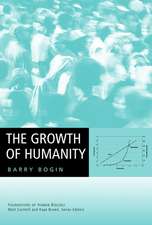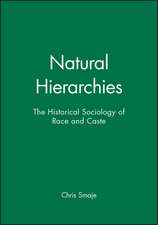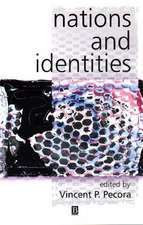The Human Lineage, Second Edition: Foundation of Human Biology
Autor M Cartmillen Limba Engleză Hardback – 17 aug 2022
Preț: 729.32 lei
Preț vechi: 959.64 lei
-24% Nou
Puncte Express: 1094
Preț estimativ în valută:
139.55€ • 145.42$ • 115.55£
139.55€ • 145.42$ • 115.55£
Carte disponibilă
Livrare economică 14-28 martie
Livrare express 27 februarie-05 martie pentru 63.96 lei
Preluare comenzi: 021 569.72.76
Specificații
ISBN-13: 9781119086703
ISBN-10: 1119086701
Pagini: 640
Dimensiuni: 228 x 278 x 41 mm
Greutate: 1.5 kg
Ediția:2nd Edition
Editura: Wiley
Seria Foundation of Human Biology
Locul publicării:Hoboken, United States
ISBN-10: 1119086701
Pagini: 640
Dimensiuni: 228 x 278 x 41 mm
Greutate: 1.5 kg
Ediția:2nd Edition
Editura: Wiley
Seria Foundation of Human Biology
Locul publicării:Hoboken, United States
Public țintă
Advanced undergraduate students and beginning graduate students in biological anthropology.Notă biografică
Matt Cartmill is Professor of Anthropology at Boston University and Professor Emeritus of Evolutionary Anthropology at Duke University. Dr Cartmill is a Guggenheim and AAAS Fellow, a former president of the American Association of Physical Anthropologists and recipient of their Charles Darwin Lifetime Achievement Award, a founding co-editor of the International Journal of Primatology, and the former editor-in-chief of the American Journal of Physical Anthropology. Fred H. Smith is University Professor Emeritus of Anthropology at Illinois State University and Adjunct Professor at the University of Colorado, Boulder. A past president of the American Association of Physical Anthropologists and an AAAS and Alexander von Humboldt Fellow, he has received awards for his work from the U.S., Ireland, Germany and Croatia. Dr. Smith has conducted research in Europe, West Asia, and Africa, and has taught internationally at the Universities of Hamburg, Tübingen and Zagreb.
Cuprins
Foreword xi
Preface to the First Edition xiii
Preface to the Second Edition xvi
Some Notes on Nomenclature xix
About the Companion Website xxi
1 The Fossil Record 1
1.1 The Discovery of the Deep Past 1
Changing Ideas About the Changing Earth 1
Neptune vs. Vulcan 2
A Brief Guide to Sedimentology 3
Dating the Rocks 4
The Succession of Faunas 5
Radiation-Based Dating Techniques 7
Other Dating Techniques 9
Dating Based on the Cycles of the Earth 9
The Problem of Orogeny 11
Continental Drift 11
1.2 A Brief History of Life 12
Life: The First Three Billion Years 12
Multicellular Life 14
The Cambrian Revolution 15
Jaws, Fins, and Feet 16
The Reptilian Revolutions 18
The Two Great Extinctions 20
The Mammals Take Over 21
2 Analyzing Evolution 23
2.1 Darwin and Evolution 23
Parsimony and Pigeons 23
Darwin's Theory 24
Improving on Darwin 27
2.2 The Origin of Species 30
What, if Anything, is a Species? 30
The Speciation Process 31
The Tempo of Speciation 32
Semispecies, Hybrids, and Isolating Mechanisms 33
2.3 Species Concepts and Classification 35
Races, Semispecies, and Taxonomy 35
Other Species Concepts 37
Morphospecies and Chronospecies 39
2.4 Microevolution and Macroevolution 40
Is Evolution Smooth or Jerky? 40
The Neo-Darwinian Synthesis 41
The Politics of Macroevolution 42
2.5 Reconstructing the Tree of Life 42
Phylogenetic Inference 42
Sources of Error in Phylogenetics 44
2.6 Taxonomy and Classification 47
Linnaean Systematics 47
Evolutionary Systematics 47
Phenetics and Cladistics 49
Pros and Cons of Phylogenetic Systematics 49
3 People as Primates 51
3.1 Primates as Mammals 51
The First Mammals 51
Allometry 57
Allometry and Early Mammals 58
Death and Molar Occlusion 59
Allometry, Motherhood, and Milk 60
Respiration and the Palate 60
The Tribosphenic Molar 62
Live Birth and Placentation 64
Jurassic and Cretaceous Mammals 65
3.2 The Order Primates 66
What is a Primate? 66
The Living Strepsirrhines 73
Anthropoid Apomorphies: Ears, Eyes, and Noses 74
Tarsiers 76
Platyrrhines: The New World Anthropoids 77
Cercopithecoids: The Old World Monkeys 78
Hominoids: The Living Apes 79
Pongids and Hominids 81
Bonobos and Chimpanzees 84
Humans vs. Apes: Skulls and Teeth 85
3.3 The Primate Fossil Record 88
Primate Origins: The Crown Group 88
Fossil Primates: The Stem Group 90
Ancestral Traits and Genetic Evidence 91
The First Euprimates 92
Eocene "Lemurs" and "Tarsiers" 94
The First Anthropoids 96
Anthropoid Radiations 98
Miocene Catarrhines 99
Ape Origins 103
Cercopithecoids 107
4 The Bipedal Ape 109
4.1 The Discovery of Australopithecus 109
Being Human vs. Becoming Human 109
The Taung Child 109
Australopithecus Grows Up 111
4.2 The Anatomy of Bipedality 115
Upright Posture and the Vertebral Column 115
Bipedality and the Pelvis 116
Bipedal Locomotion: Knees 118
Bipedal Locomotion: The Hip Joint 123
Bipedal Locomotion: Feet 124
4.3 More South African Finds 127
Australopithecus Stands Up 127
The Skull of Australopithecus africanus 128
Australopithecus robustus 129
Man-Apes, Just Plain Apes, or Weird Apes? 133
Postcranial Peculiarities 133
4.4 Louis Leakey and Olduvai Gorge 135
4.5 Mio-Pliocene Enigmas 139
Sahelanthropus: The Oldest Hominin? 139
Orrorin 140
Ardipithecus 141
The Burtele Foot 146
4.6 The Genus Australopithecus 146
Australopithecus anamensis? 146
Australopithecus afarensis? 148
Afarensis Skulls and Teeth 152
Australopithecus bahrelghazali? 153
Australopithecus deyiremeda? 153
Kenyanthropus platyops? 154
Early Australopithecus from South Africa 154
Australopithecus prometheus? 155
Australopithecus aethiopicus 156
Australopithecus garhi 158
Australopithecus sediba? 159
Australopithecus boisei 160
Australopithecus robustus: Postcranial Skeleton and Relationships 162
4.7 Australopithecine Phylogeny 163
Alpha Taxonomy and Cladograms 163
Getting Around Cladistics 166
4.8 The Australopithecine Postcranium 167
Down from the Trees - How Far, How Fast? 167
Australopithecine Shoulders 171
Arms vs. Legs 172
The Hominin Hand 173
Australopithecine Vertebrae 174
Hip and Femur 177
Early Hominin Feet 179
Postcranial Diversity in Early Hominins 181
4.9 Ecology and Behavior 183
The Facts Thus Far 183
What Did Australopithecines Eat? 183
Early Hominin Environments 186
Social Ecology 188
4.10 Major Issues: Explaining Hominin Origins 192
5 The Migrating Ape 197
5.1 The Spread of Hominins out of Africa 197
5.2 The Emergence of the Genus Homo 198
Homo habilis and the Habilines 198
Habiline Dates and Stratigraphy in East Africa 203
Habiline Skulls 204
Habiline Teeth and Diets 207
Habiline Postcranial Remains 208
Habiline Taxonomy: The Frustrations of Variation 210
Back to South Africa 211
Advanced Australopithecus or Early Homo? Phylogenetic Issues 212
Early Material Culture 214
A Summary of the Habilines in Eight Questions 215
5.3 Homo erectus 216
An Introduction to Homo erectus 216
A Brief History of Homo erectus: 1889-1950 218
Later Discoveries in Africa and Eurasia 220
Erectine Chronology and Geographic Distribution 222
Asian Homo erectus: The Neurocranium 224
Cranial Capacity and the Brain in Asian Erectines 229
Asian Homo erectus: Faces and Mandibles 230
The Asian Erectine Dentition 232
Asian Erectine Postcranial Remains 233
Early African Erectine Skulls and the Ergaster Question 233
Early African Erectine Postcranial Morphology 237
Early Erectine Adaptations: Anatomy and Physiology 242
Early Erectine Adaptations: The Archaeological Evidence 245
Patterns of Development and Evolutionary Change in Erectines 247
Early Erectine Radiations in Africa 248
Out of Africa I: The First Migration into Eurasia 250
Dmanisi - The First Eurasians 253
Indonesian Erectines and the Specter of "Meganthropus" 259
Chinese Erectines 261
The Initial Occupation of Europe 262
Gran Dolina 264
5.4 Peripheral Holdouts along the Continental Margins 267
Flores 267
Luzon 272
Dushan 272
Rising Star 273
5.5 Major Issues: Summing Up the Erectines 275
6 The Big-Brained Ape: Middle Pleistocene Variants and Trends 279
6.1 Homo "heidelbergensis" 279
Crossing the Rubicon? 279
"Archaic Homo sapiens" vs. "Homo heidelbergensis" 280
Brains and Tools in the Middle Pleistocene 282
6.2 Models of Later Human Evolution 284
Changing Origin Narratives 284
The Piltdown Fraud 285
RAO and MRE 287
6.3 Regional Variants in Europe and Africa 289
European Heidelbergs 289
Petralona 290
Bilzingsleben 293
Swanscombe 293
Steinheim 294
Mauer 295
Boxgrove 296
Ceprano 296
Arago (Tautavel) and Lazaret 297
Sima de los Huesos 298
Other European Heidelbergs 303
African Heidelbergs: Kabwe 304
Bodo and Ndutu 306
African Heidelberg Mandibles 307
Other African Heidelbergs 307
North Africans 308
6.4 Asian Heidelbergs? 308
Mugharet El-Zuttiyeh 308
Other West Asian Candidates 309
South Asia 309
East Asia 309
6.5 Australasia 311
Sambungmacan 311
Ngandong 312
6.6 Supraorbital Tori, Chins, and Projecting Faces 314
6.7 The African Transition to Modern Humans 316
Background and Dating 316
The African Transitional Group: Vault Morphology 319
The African Transitional Group: Facial Morphology 320
The African Transitional Group: Additional Bones, Archaeology, and Other Matters 321
6.8 East Asian Archaic Humans 322
Background and Context 322
Dali 324
Harbin 325
Other Chinese Finds 325
East Asian Archaics: Continuity or Someone New? 326
6.9 Major Issues: Speciation, Migration, and Regional Differentiation 327
7 Talking Apes: The Neandertals 333
7.1 Changing Ideas about Neandertals 333
Early Discoveries and Interpretations 335
Neandertals - From Boule to the Twenty-First Century 338
7.2 Neandertal Chronology and Distribution 340
7.3 The Neandertal Skull 346
Neandertal Braincases 346
Neandertal Faces 356
Neandertal Mandibles 359
Neandertal Teeth 362
Prognathism 364
7.4 The Neandertal Body 366
Body Size and Proportions 366
Neck and Upper Limb 369
Lower Vertebrae, Pelvis, and Lower Limb 371
7.5 Neandertal Life History and Demography 374
7.6 Genetics and Genomics 376
The Mitochondrial Genome 376
The Nuclear Genome 378
Genes, Dates, and Lineages 379
Denisovans 380
Ghosts in the Genes 382
7.7 Brains and Behavior 383
Neandertal Brains 383
Neandertal Technology 385
Symbolic Behavior 386
Neandertals and Language 389
Diets and Subsistence Behavior 393
7.8 Neandertal Populations 395
Early European Neandertals 395
Krapina 396
"Würm" Neandertals from Western Europe 398
Western and Central Asian Neandertals 399
Late Neandertals 402
7.9 Major Issues 406
8 The Symbolic Ape: The Origins of Modern Humans 411
8.1 Symbolic Behavior 411
Signs and Symbols 411
A "Creative Explosion"? 412
8.2 Modern Human Anatomy 414
The Modern Skull 414
Cranial Capacity 416
The Postcranial Skeleton 417
8.3 The Fossil Record of Modern Human Origins 418
Geochronology 418
Early Modern Humans: The East African Record 418
Out of (East) Africa: Early Modern People in North and South Africa 421
The First Modern People Outside Africa: The Near Eastern Evidence 424
African and Circum-Mediterranean Gene Flow and Modern Human Origins 430
Modern Human Origins in East Asia 432
The First Australians 437
Europe: A Late Frontier 443
The Initial Upper Paleolithic 444
The Aurignacian and its Makers 445
The Gravettian 450
The Late Entry into Europe 452
Europe: The Morphological Evidence for Continuity 453
8.4 Genetics and Modern Human Origins 455
Genes, Populations, and Migrations 455
Human Self-Domestication? 459
Ancient DNA in Early Modern Humans 460
8.5 Modern Human Origins: The Models vs. the Data 461
The Recent African Origin Model 461
Multiregional Evolution 462
Alternative Views: The Assimilation Model 463
Assimilation and Interactions Between Modern and Archaic Humans 466
Appendix: Cranial Measurements 471
Bibliography 477
Index 583





















